p. 6

First-generation students face challenges












that makes them so similar is the number of lifetime ovulations.”
He said the process of ovulation, which involves the egg erupting through the surface of the ovary, leads to the development of scar tissue. It’s during this healing process that fibrosis, or toughening of the tissue, can go awry and lead to the development of cancerous tissue.
According to his research, Omega-three acids help to not only prevent the development of ovarian cancer, but also reduce the severity of cancers that do develop. He said flaxseed, when introduced into a diet, creates Omega-three acids which compete with the naturally produced inflammatory proteins, reducing inflammation and allowing for faster, more efficient healing of tissue.
system, there are cannabinoids produced inside our bodies, cannabinoids produced inside our body, and they’re binding to specific receptors, one and two,” Roy said. “So two is not that much expressed in the ovary, but receptor one is there in high abundance, and it seems like the expression of those receptors increases in cancer.”
She says the protein she is specifically focusing on at the moment is called TGF-ß, which has many different iterations and is present in the ovaries and throughout the broader endocannabinoid system.
Research is being conducted at SIU by the Cannabis Science Center to determine the relationship between cannabinoid proteins and potentially cancerous ovarian cysts.
Dr. Dale “Buck” Buchanan, a researcher and professor of physiology at SIU, was one of the founding members of the Cannabis Research Center. He helped to pull together a dream team from various departments across the SIU system to create a pool of skilled experts passionate about the research.

“We have faculty in the School of Law, the College of Health and Human Sciences, in the Rehabilitation Institute, School of Medicine,” Buchanan said. “We have the Center for Rural Health and Social Services as a component of that.”
Hemp was previously classified by the Drug Enforcement Administration (DEA) as a “Schedule 1 drug,” making it illegal to handle or research except under extremely strict government supervision. The Agriculture Improvement Act of 2018, commonly known as “The 2018 Farm Bill,” removed hemp and hemp seed from the classification, opening up the plant to independent researchers.
“We started the Cannabis Science Center in [...] December 2018, when they took it off of the controlled substances lists and legalized use of industrial help nationwide,” Buchanan said. “Since then there has been an amazing explosion.”
He said one of his particular areas of interest since the reclassification of hemp has been investigating cannabis and the truth behind the
cultural narrative around its anticancer properties.
“The vast majority of ovarian cancer research is focused toward extending what we call ‘progressionfree survival,’” he said. “So it seems misguided to me that the focus of the research is on this incremental increase in life, [...] so we’re really interested in prevention.”
Buchanan said one of the biggest issues in researching ovarian cancer is a lack of viable animals to test but found a way around it with an unlikely solution.
“It’s not a natural disease in rodents, but rodents are the easiest thing to study,” Buchanan said. “But the chicken is kind of counterintuitive. It gets the same ovarian cancer that women get. Women give live birth and chickens lay eggs, but the ovaries are remarkably similar and the thing
“The consequence of this is that it has a 70% reduction in the severity of cancer and a 30% reduction in the incidence, and all we did was introduce flax into their diet,” Buchanan said. “But we know nothing about how it works, so that’s our work.”
He said the search for what causes the dramatic effects of introducing flax into the diet has brought an examination of the system of protein receptors throughout the body that react to internally produced and external, or exogenous, cannabinoids, also known as the endocannabinoid system.
Didas Roy, a graduate student assisting in research, said the endocannabinoid system likely plays some role in the production of ovarian cancer, but it is not yet known what exactly the relationship is between the two.
“So in the endocannabinoid
“We know TGF-ß is also implicated in cancer, so we are trying to see how the both of them are related to each other, who is controlling whom and how they’re contributing to the ovarian cancer,” Roy said. “TGF-ß is a family of many, many receptors and ligands, so I’m trying to look at all of them.”
She said the idea of analyzing the process is a brute force process, requiring testing of each particular protein until the correct one is found before continuing with the next step of the process and starting over again with the next phase.
“Right now, I’m just trying to confirm the primary sequences that I can look into and that’s what I found. Now we will try to see whether one or more of them get upregulated in cancer, so we can kind of tie them in and then we go downward in the downstream process,” Roy said. “We can see this specific subtype that is getting unregulated in cancer, so that will tie up the entire story.”
Reenactor makes history come alive
“TÁR” is one of the most powerful films of the last decade
The Dawg Pound brings it’s “Banterra Magic”News Editor William Box can be contacted at wbox@dailyegyptian.com

Email: editor@dailyegyptian.com
Faculty Managing Editor: Annie Hammock ahammock@dailyegyptian.com
Editor-in-Chief: Sophie Whitten swhitten@dailyegyptian.com
Design Chief: Seth Martin smartin@dailyegyptian.com
Photo Editor: Domonique MartinezPowell dmartinez-powell@ dailyegyptian.com
Multimedia Editor: Kylen Lunn klunn@dailyegyptian.com
Sports Editor: Joey Bernard jbernard@dailyegyptian.com
Assistant Sports Editor: Cole Daily cdaily@dailyegyptian.com
News Editor: William Box wbox@dailyegyptian.com
Ad Chief: Hannah Combs hcombs@dailyegyptian.com
Assistant Ad Chief: Isaiah Wilkerson isaiah@dailyegyptian.com
Social Media Editor: Logan Brown lbrown@dailyegyptian.com
The Daily Egyptian is published by the students of Southern Illinois University Carbondale on a weekly basis. Fall and spring semester editions run every Wednesday. Free copies are distributed in the Carbondale, Carterville, and Springfield communities. The Daily Egyptian can be found at www.dailyegyptian.com or on the Daily Egyptian app!
The Daily Egyptian, the student-run news organization of Southern Illinois University Carbondale, is committed to being a trusted source of news, information, commentary and public discourse, while helping readers understand the issues affecting their lives.

The Daily Egyptian is published by the students of Southern Illinois University Carbondale and functions as a laboratory for the School of Journalism in exchange for the room and utilities in the Communications Building. The Daily Egyptian is a non-profit organization that survives primarily off of its advertising revenue. Offices are in the Communications Building, room 1259, at Southern Illinois University Carbondale, Carbondale, Ill., 62901.
@2021 The Daily Egyptian. All rights reserved. All content is property of the Daily Egyptian and may not be reproduced or transmitted without consent. The Daily Egyptian is a member of the Illinois College Press Association, Associated Collegiate Press, College Media Advisers Inc. and the College Business and Advertising Managers Inc.
Letters and guest columns must be submitted with author’s contact information, preferably via email. Phone numbers are required to verify authorship, but will not be published. Students must include their year and major. Faculty must include rank and department. Others include hometown. Submissions should be sent to editor@dailyegyptian.com

On the afternoon of November 9, nearly 50 demonstrators showed their support for the Carbondale Education Association (CEA) by picketing in front of Lewis Elementary School.
The protest came as a result of an ongoing contract dispute between the CEA and the School District 95 Board in which the CEA has already filed an intent to strike.
“We’ve been working without a contract since the beginning of the school year,” said Cecile McCarron, a regional council representative for the CEA. “We want to catch up. We want fair contracts.”
She said the negotiations for a contract with the CEA were supposed to begin in March of 2022, but did not come to the table for discussions until June for contracts set to begin in August.
“They’ve met but we have not been meeting face to face. They have refused to meet with us face to face,” McCarron said.
She said the four main points of contention in their negotiations are maintaining an equal class size among classrooms, increasing the planning time allotted for their lessons, maintaining their current retirement package and health insurance coverage for their 134 teachers.
“Carbondale Middle School departments are seeing class sections with enrollments that are not balanced,” she said. “Some teachers are working with double or even triple the number of students as others with the same job title, so it’s quite a concern.”
A community release from the President of the District 95 School Board, Catherine Field, released at the end of the school day November 9, addressed the grievances of healthcare and retirement from the other side of the negotiating table, though it
neglects to address educators’ concerns with classroom sizes.
“As matters currently stand, the outstanding items being negotiated center mostly on economics: retirement incentives, salaries and health insurance,” she said.
She said Carbondale Elementary provides approximately 9% of the annual income of instructors to the Teacher’s Retirement System (TRS).
According to her, the amount, combined with a package that pays teachers additional amounts scaling with their salary during their last five years up to $12,500 with the district before retirement, cannot be financially maintained indefinitely.
“The retirement incentive and salaries in place for Carbondale Elementary teachers during their last working years are not sustainable for the district financially,” Field said.
McCarron said the plan is necessary for teachers as TRS serves as the pension system for educators in Illinois.
“The cost savings for [the cut to retirement benefits] is huge. Teachers do not get Social Security,” she said. “We should value our long serving educators and ensure that benefits they have been promised will be here when they need it most during our retirement years.”
Field said the average salary for Carbondale Elementary teachers sits at $71,054 before benefits, making them some of the highest paid teachers in Southern Illinois. Morgan Kozlowski, a student in the SIU Teacher Education Program, said this covers only a part of the truth.
“What the [community release] didn’t say was how that was the average of all of the district employees, so all of the six figure people up at the top, not just the underpaid teachers,” Kozlowski said. “So it really fluffed up that number to make it look like all the teachers were making a fair amount of money.”
According to a document on the District 95 website, the salary of teachers entering with a Bachelor’s degree begins as low as $45,313 per year, building up over the length of the instructor’s tenure. However, the district’s average rate of retention for teachers over the past 6 years according to its Illinois Report Card amounts to 81%, growing quickly up to its current height of 89% for the 2022-23 school year.
In a previous interview with McCarren, she said the large amount of turnover at the school makes properly educating students more and more difficult.
“When we have fewer educators, other teachers are forced to pick up the work. It adds extra responsibility and stress to the system,” she said.
The combination of high turnover and low starting wages at the school indicate a discrepancy in the presentation of Field’s argument, as the number of teachers with Bachelor’s degrees accounts for nearly half of the employed educators according to the Illinois Report Card, necessitating the inclusion of much higher salaries to reach the $71,054 benchmark.
“[Fields] conveniently leaves out some things, especially some things that we talk about in our talking points,” said Amber Ragsdale, president of the CEA. “She’s not giving the full picture. No, she’s painting it, obviously, from their side.”
McCarron said a school board meeting took place Thursday, November 10 and asked community members to come and show their support.
“We can come together and get a fair contract that not only benefits the teachers, but most importantly students and the community,” she said.
The intimidating, rhythmic sound of drums approaches from a distance. A group of 11 men and one large black dog comes marching by. The morning is cool and cloudy, and every man has a stoic, focused look on their face. The majority of the group is decorated with matching blue coats accented in red, with a black, feathered hat atop each head. They appear to have fallen right out of the 1700s, and no piece of modern times can be seen among them.
The man leading the small group wields a lance lined up vertically with his body. The following eight men all wield flintlock rifles with the stock of the gun resting in their left hand and the barrel of the gun sitting on their left shoulder. The man with the dog marches next to the drummer, who marks the end of the group.
“You go down to Fort Massac now and you see his group, and there might only be six or seven there, but there’s a lot more in the group,” explains Gary Emery, a friend of one of the men.
Every one of them will have countless hours of stories to tell about their travels. A particular man situated near the front, with one of the best looking rifles, is especially wise and skilled. A historical reenactor and gunsmith, Jim Wallace is also a vital member of the community.
Over the summer, from late April until Labor Day weekend, Wallace works six days a week at the Bass Farms produce stand in Marion. He can be found peddling a large variety of fruits and vegetables, with strawberries being the biggest seller. Wallace also puts hours of work into his own blueberries and blackberries in order to sell there.
On top of this, he is also always willing to share historical knowledge to whoever will lend a listening ear. Wallace’s favorite subject is Lewis and Clark, and he has even followed their exact path across the United States.
“That trip took three years and 23 days, and I could probably tell it all to you in half that time,” he jokes.
Wallace and his group were extremely detail oriented during their journey.
“Every day when we started out, we put up the flag in the morning and then we’d read the excerpt out of the journals,” he explains. “What they did

that day, what happened. We tried to be in the same place that they were, on the same day that they were there.”
Wallace first met the group he traveled with in 1998 at Fort Massac in Metropolis, which has an annual Revolutionary War-era reenactment and mock battle that he has attended for around 30 years.

“Fort Massac was a place where Lewis and Clark originally stopped,” he recounts. “So they came down to just see it. I got to talkin’ to those guys, and I thought this is pretty neat. I think that’s something I’d want to do. And so I fell in with them and been with them ever since, and it’s been an interesting journey.”
Their long journey was planned because it was the bicentennial of Lewis and Clark’s original expedition.
“They started in August 31st of 1803. We started August 31st of 2003. Of course, the river is quite different now, locks and dams, and barges and those types of things, but you could still get a feel of it, if you just kind of let your mind wander a little bit, you could really get a feeling of it,” Wallace said.
During the planning of their expedition, Wallace and his group contacted many schools and historical societies to come to the rivers and learn about the story of Lewis and Clark.
“I’d say that we probably talked to a half a million kids across the United States. That was quite interesting, and I just hope that maybe one of them remembered what they learned along the way,” he said.
Wallace’s group also built and used their own reproductions of the boats Lewis and Clark used based on the writings within those explorers’ journals.
“We built the boats over in St. Charles, Missouri,” he recounts. “There were drawings and descriptions in the journals of the boats. None of us were boat builders. One guy was a dentist, and several were doctors and lawyers, bankers and farmers, and you name it. One guy was a cabinet maker… He had some skills and he had some tools that we used. NASA had a couple guys that actually helped make drawings of the boats, and some of the things we did were experimental.”
Over the winter, Wallace spends his free time making flintlock rifles
and pistols, and he has even made a copy of the gun used by Mel Gibson in The Patriot.
“I’ve made several guns, all flintlock. I don’t make any percussion guns or modern guns… Percussion became popular about 1830, and I think was invented about 1813 or ‘14… That’s too modern for me,” he joked. “My favorite period is like 1760 to 1770.”
On top of the long and detailed task of making a flintlock, Wallace is determined to make the entire process as authentic as possible to the gunsmiths of old.
“I use all these chisels you see lined up here, and files, and rasps… The only two power tools I use are this
band saw to make the rough shape of the gun, and then I use that drill over there because it’s accurate…” he shows. “I try to do it like they would have done it originally.”
Jim Wallace’s wife, Sue Wallace, surprisingly does not mind that he spends so many hours in his shop working on guns.
“I’m very happy that he has something to do, that he is interested in, that is not sitting and watching television like most people his age,” she said.
Though he does sell some of the guns that he has made, Jim Wallace does not make them to obtain a profit. He simply makes them over the winter for something to do.
“I don’t make them to sell, I’ll make one for me, and if somebody sees it and likes it and wants to buy it, I might go ahead and sell it to them… I really don’t know how many I’ve made actually,” he said.
Jim Wallace will most likely continue working at Bass Farms, building guns and reenacting until he is physically incapable. While he is still working, he is absolutely worth a visit and some conversation. Anyone could learn many things from this lover of a particular moment in history.
SIU has decided to acknowledge and celebrate Native American Heritage Month in November with various events held throughout the month to help educate the community.

Programs sponsoring the events include the Office of the Vice Chancellor for Anti-Racism, Diversity, Equity, and Inclusion, the Student Multicultural Resource Center, and the Paul Simon Public Policy Institute.
An administrative aide from SIU’s School of Medicine, Krista English, who’s a member of the Assiniboine tribe, said this month is to inform the public about indigenous people’s culture and customs to this day.
“I think a lot of people have this almost caricature of who Native people are in their mind just based on, like, the old Hollywood,” English said. “So for me, Native American Heritage Month is just shining light on who indigenous people are, what their contributions are.”
English said Student Multicultural Resource Center director Renada Greer reached out to her for an advisory role on the planning committee for events.
“I will advise, like, how we can steer that in a, you know, a more inclusive or a more respectful way,” English said. “Just kind of being, just like, the lived experience part of that because
there’s not a lot of indigenous people here on campus or in this area in general.”
English is hosting her own event, which is a lunch and learn on Nov. 16 from noon to 1:30 p.m. in the Old Main Room of the Student Center. It will focus on missing and murdered indigenous women.
“Specifically, and the rate for which they’re being murdered and going missing. I share some statistics and personal stories,” English said. “Just some information on what’s being done. Why this is happening in the first place and how it can be fixed.”
Native American studies advisor Dr. Gray Whaley has been involved off and on with planning events this month since he arrived in the early 2000s.
“We’ve had a lot of guests who are artists, filmmakers, poets, from Navajo Nation, a historian from Washington State,” Whaley said. “If you look at my 16 years here, quite a number of different tribes and different regions of the country and having guests here.”
Whaley was a professor who reached out to the school to see what they were planning for the month.
“[Diversity Chancellor] Dr. [Paul] Frazier was very open to pulling something together and he kind of, you know, he said, he had mentioned a staff member.
I assumed he meant Krista,” Whaley said, “I told him that I would reach out to faculty…and so I got lucky my first contact I reached out to Dr. Wagner over in the center for archaeological… investigations.”
Director of the Center for Archaeological Investigations Mark Wagner helped the school find a guest speaker.
“I recommended that they contact a member of the Cherokee Nation named Troy Wayne Poteete and he is a Supreme Court justice for the Cherokee Nation in Oklahoma,” Wagner said. “He’s also the executive director of the Cherokee Trail of Tears Association.”

The event has been postponed with Poteete currently having COVID-19.
Wagner said Poteete is very knowledgeable and wanted him to come to speak to show Native Americans live amongst society in the modern world.
“I think a lot of people have an idea that Native Americans don’t really exist as modern, modern people, or they still tend to think of them as very traditional people,” Wagner said. “Whereas, in fact, they’re all members of the modern world and Troy is a very good representative in that way.”
Staff reporter Jamilah Lewis can be reached at jlewis@ dailyegyptian.com or on Twitter @jamilahlewis.
To get ready for its 100-year anniversary, Sigma Gamma Rho Sorority Inc. put on a variety of events throughout the week of Nov. 7, from volunteer opportunities to trivia nights.
Anyea Robinson, the antigrammateus for Sigma Gamma Rho, said she joined the sorority after seeing how welcoming the environment was.
“I just saw that sisterhood and the bonding and the type of way that they carried themselves. Also, my father is a part of a D9 fraternity Iota Phi Theta, and when I saw him surround himself around likewise women, I looked at myself and I was like, ‘that’s something I want for myself in the future,’” she said.
Robinson said, since Sigma Gamma Rho turned 100 on Nov 12, they had a new member presentation in the Student Center Auditorium. She said introduced the newest members to campus and had a party afterward.


Sigma Gamma Rho put on its first-ever Are You Smarter Than a Poodle contest on Nov. 8 in Guyon Auditorium. There were two teams, team one was made up of audience members and team two was made up of Sigma Gamma Rho members.
The members of team one were Max B, Daniel Bethers, and Natiqua Williams-Sanders. Team two was sorority sisters Naya Shapiro, Britney Mosby, and Briyanna Robinson.
For the first round, Max B and Naya Shapiro went against each other. The categories that were mainly picked were spelling and riddles. Toward the end of the round, a tie-breaker was announced. The tie-breaking question was ‘What is yours, but mostly used by others’. Shapiro answered “your name” to break the tie.
Shapiro, the vice president of Sigma Gamma Rho, said when it came to planning Are You Smarter Than a Poodle, tasks did have to be delegated between members.
“We have like about three or four people working on each task together. So, this wasn’t my task to work on,” Shapiro said. “We usually split up the tasks between people like the days so everything can be divided, so it’s not just on everybody.”
She said next year if they do decide to do Are You Smarter Than a Poodle again they could possibly add more questions and categories.
A second round took place, this time between Nautica WilliamsSanders and Britney Mosby. For this round, both contestants choose mainly spelling and math.
Nautica Williams-Sanders, a third-year student said she
enjoyed taking part in the game and people who did not come would have liked it a lot.
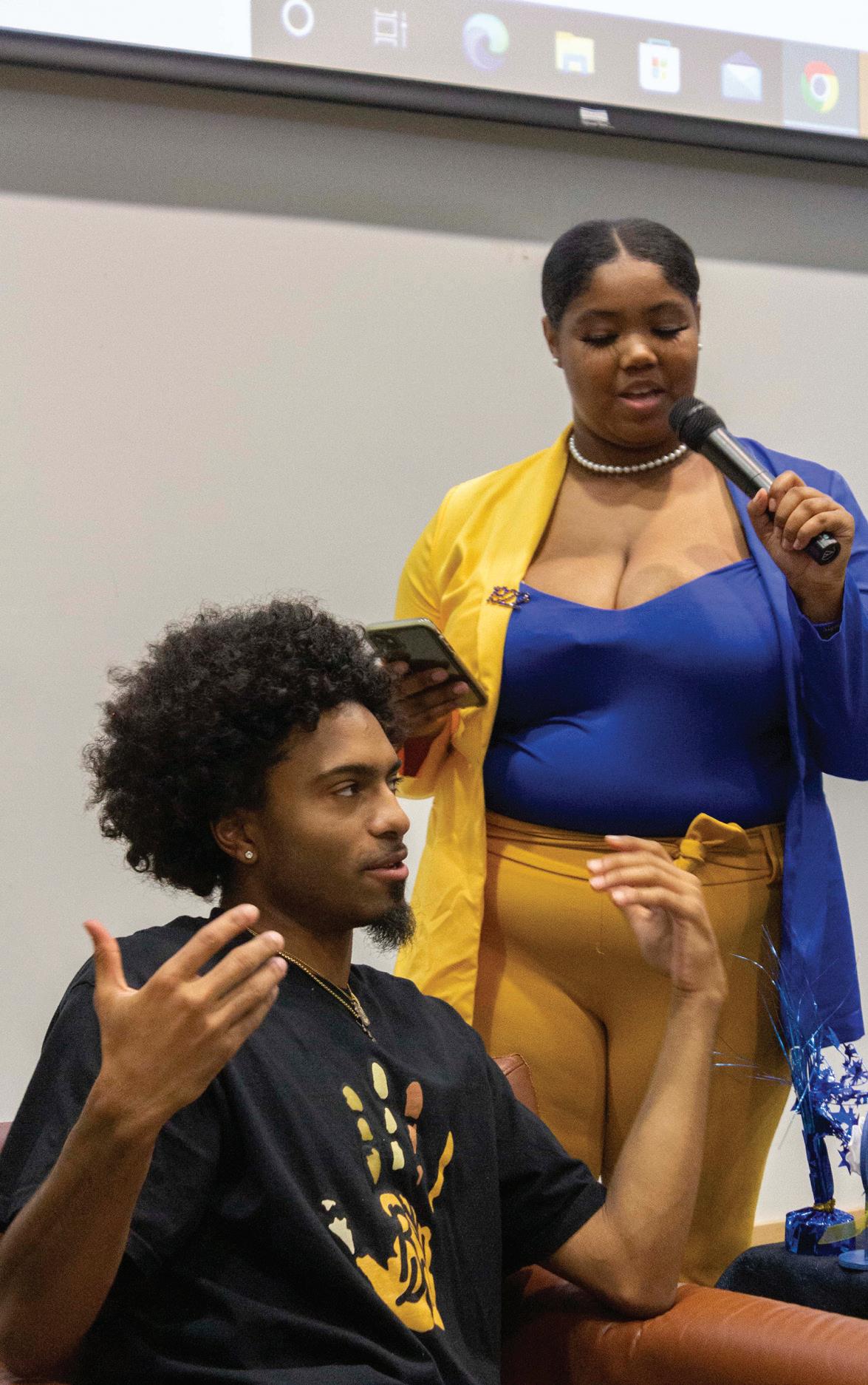
“People will like just the different categories that they had, the different challenges towards the end when they make the contestants go against each other. I think they’ll probably like that to see if they can beat each other,” she said.
Sigma Gamma Rho was in the lead with two wins against Team one. The third round was between Daniel Bethers and Briyanna Robinson. With this round,
Sigma Gamma Rho took the win, “proving” poodles are smarter.
To end the night, a round between all three contestants on team one was held, they went up against each other and the contestants were asked questions from the spelling category. Max B won the round and all of team one members won a Starbucks gift card.
Staff reporter Janiyah Gaston can be reached at jgaston@ dailyegyptian.com or on Twitter @DEJaniyah
The entire nation celebrated First Generation Day on Nov. 8, honoring students who pursue a college degree despite having fewer resources to draw on compared to students with the benefit of their parent’s experience with the education system and guidance in life. The holiday was first created by the Council for Opportunity in Education in 2017. K-12 schools and Colleges across the country celebrated the resourcefulness and ambition of first generation students, joined by various companies and nonprofits.
SIU’s own First Generation celebration spanned the whole week, including free snacks, meet-andgreets with first generation students and staff from the First Saluki Center and presentations providing first generation students with advice and encouragement as they break new ground for their families. The First Saluki Center is an SIU organization dedicated to connecting first generation students with resources providing everything from academic support and financial literacy to emotional support.

Support for first generation students is an especially important issue given that many are racial minorities from lower income backgrounds who didn’t receive equal opportunities compared to other students, according to the Postsecondary National Policy Institute (PNPI). First generation students, and many other variations of disadvantaged students, seldom get the media attention they deserve because it can be difficult to discuss the true magnitude of the difference that socioeconomic class and race can make in our own system without becoming embroiled in racial tensions, and the political polarization that has swept the nation in recent years.
Fortunately, American students aren’t the only students on campus. SIU is a bastion for a vibrant international community. Looking through their eyes, the meaning of education, which many from western countries take for granted, is unspeakably profound.
For many first generation Indian students, with education comes the only hope of ever escaping India’s dictatorial caste system.
“I don’t have a last name,” said Ashish, an Indian graduate student working on his second masters degree in Communications. “Usually in India, from the caste I come from, we don’t have last names or surnames. We use the first letter of our father’s name as an initial. So my full name in India is Ashish Kumar T. [...] Our community is not encouraged to have them: we don’t have a surname. It denotes our caste, it denotes discrimination, it denotes lots of things. We come from a very marginalized society in India.”
When he came to the United States, he lost his first name as well, when a mistake was made on his visa, labeling his first name unknown, leaving him with only his middle name, Ashish, and his determination to make a difference with it.
“I don’t see caste, I don’t see race, I don’t see gender. For me, everyone is a human being, as a humanitarian born, as an egalitarian society. I see that [society] must be born into life for the survival of this mankind,” Ashish said.
Ashish is a human rights activist back in India, and has been since he was ten. He has continued his activism during his time at SIU, creating several notable short films highlighting issues of discrimination, education, caste, and extremist violence in India, including his film “Caste and Counterview” which won a local film prize and was promptly banned.
“We raise a lot of issues in India, irrespective of whichever government it comes from, our thing is to raise questions,” Ashish said. “The fundamentalists are growing very much. To use the word fundamental and the word fascist in the U.S. is so hard, like, people get scared when I use these words, it’s so tricky. People tell me, well my well-wishers, don’t use the word too much here, they will define you. But I’m talking about the facts and I have facts with me. If I don’t do that, then what is my identity over here?”
Ashish believes the current regime of India to be worthy of this description,
deriding the current Prime Minister as a fascist fundamentalist. He believes the current government is frighteningly fundamentalist, in part due to his decade of experience working with the indigenous groups in central India. During that time, indigenous people have been forcefully relocated and evacuated from tribal villages for the sake of environmentally destructive open pit mining operations, especially those controlled by the two richest Indians in the entire country of 1.4 billion people, Gautam Adani and Mukesh Ambani.
Ashish’s own education has assisted him greatly in organizing protests and getting access to mentors and perspectives that he wouldn’t have if he had remained stuck in the default position of members of his caste in India. Historically, Indians were culturally divided into castes with predetermined worthiness based on the Hindu concept of karma. This resulted in members of higher castes getting preferred treatment in most aspects of life, including education and employment.
Castes were generally adhered to by the British colonizers of India at first, and even encouraged by policies rewarding higher caste members with
positions in the government. Later in the country’s history, castes would lose official recognition and India would install systems of affirmative action designed to reduce inequality between castes. Ashish’s caste is part of a group known as the Scheduled Castes (SC), which are constitutionally recognized to be among the most vulnerable groups in India, with the exception of Scheduled Tribes (ST).
Ashish’s own caste was called “untouched” and treated as dirty by higher castes. His people were historically chased from state to state, and were not permitted to attend school past a basic level of education. His father and his grandfather before him were unable to achieve higher education for that reason, and worked as a factory worker and a truck driver respectively, all their lives. Having 12 siblings meant that Ashish’s father never had the money to attend school, passing the burden of poverty down to Ashish’s generation of the family.
Because he was a casual student that flunked his subjects often, Ashish’s parents assumed that his generation of the family would continue the trend.
“Then I realized that, no, this is not my life. Education is the most important tool,” Ashish said. “I started
reading a book called Alienation of Caste, which was a heavier book than I realized, by an author who is also a first generation student and I changed my mind. He tells us three important concepts, ‘educate, agitate, organize’.”
After reading the book, Ashish felt he had been given the power to better the situation of his own community.
“You have the rights to fight, but if you don’t know anything, how will you fight,” Ashish said. “How will you raise questions?”
Much like in the United States, there are many barriers between lower class students and their degrees. Unwilling to attend government schools due to the dismal quality of education there, Ashish and many other Indian students the Daily Egyptian talked to were forced to rely on their families for their school fees. His own sister gave up her education to send Ashish to school after his father told them he only had money to send one of them.
“Getting first generation opportunities is not easy, because you don’t know what you want to do. You don’t know who to ask. You don’t know what to do, where to go, and for me it was so tough, because I didn’t want to do engineering or finance, I wanted to be in the art world, and I couldn’t explain this to my parents,” Ashish said. “For them, art is different. Art is painting, art is song. But they wouldn’t understand film as a space because they think, ‘you’ll be excommunicated, you’ll be kicked out of the industry. Why are you risking your life and doing these things?’”
Thanks to his education, Ashish is able to do extensive community work in India. He and his friends started an organization called the Ambedkar Student Association. The group visits natives in the southern part of India, and encourages them to apply for higher education, teaching them how to be competitive in exams and college applications, regardless of their caste.
For many students from the more impoverished areas of India, education is more than an issue of their own betterment, or even the long term improvement of their community. They are their families’ ticket out of prospectless poverty and hard labor for life.
“Family is the first priority in India. We are so associated and close, we talk two times a day with our family, after coming here, even,” said Mandeep Redhu, the Indian president of the International Students Council at SIU, “Everyday. I am kind of unlucky because I’m not with them always. I was just a kid doing my tenth grade when I left home.”
There are few things more respected in Indian society than children who respect their parents, and pay them back for their upbringing.
At 10 on one crisp Wednesday morning, Mike Ricci unlocks the front door of his shop and steps outside with a cigarette between his fingers. Above him, large green letters spell out the words: “Guitars: Buy, Sell, Trade.”
Mike’s Music, located on Carbondale’s Main Street, is the result of its owner’s rollercoaster career in the music industry and his love for the college town that first drew him to Southern Illinois in the late 80s.
The store has been open for nearly 30 years, and while Ricci has toyed with the idea of moving or selling the store, he has no plans to do so any time soon.

“Everyone gets sick of anything if you do it long enough, but I love what I do,” he explains. “We sell music. I mean, how awesome is that?”
Inside the shop, dozens of guitars hang on the walls and on fixtures in the center of the room. Towards the back, smaller items are on display in glass cases and on the wall behind the checkout counter. A table just in front of the counter is cluttered with tools and supplies for instrument repairs.
Ricci, a short man with a charismatic smile and more hair on his chin than on top of his head, sits down on a stool next to the table and begins to recount the moments of his career that led to the opening of the shop.
The 59-year-old business owner grew up in a close-knit neighborhood in the Chicago suburb of Des Plaines. It was in this neighborhood that he would meet lifelong friends and bandmates and where his passion for music would first be ignited.
Ricci’s mother loved reading and music, which was apparent in his childhood home. He has vivid memories of the shelves that filled his living room growing up.
“All of the walls had bookshelves and then the bookshelves had album spaces on the bottom…The entire gigantic living room was nothing but LPs and books.”
The first instrument Ricci learned how to play was the trumpet, inspired by American musician Harry James. He says he was about eight years old when he told his mom that he wanted to play the trumpet and become a musician.
A pivotal point in Ricci’s music career occurred a few years later when his older sister and her friend brought home acoustic guitars one afternoon. He becomes animated as he remembers the girls playing music and singing and the amazement he felt listening to them.
His jaw dropped to the floor, and in that moment, he thought to himself, “I must do this. I must do this.”
Afterwards, he started teaching himself how to play with nothing but a chord chart and a few pages of sheet music, and he continued to play all throughout his childhood and teenage years.
“By the time I was 18 years old I was playing in a punk-rock band, the Sockets,” he said.
This band, formed by Ricci and his
high school friends, was his first of “too many to mention.” They were performing in front of audiences by the second semester of their senior year, covering artists like Alice Cooper.
After high school, Ricci attended community college and worked parttime for a few years until a friend, who was attending Western Illinois University, persuaded him to go to Macomb, saying that it had a fun party scene and tons of bands.
During his time there, Ricci says he “played in a band, and stayed drunk the entire nine months.”
He failed out of Western that first year and moved back home, working multiple jobs until the fall of 1985. It was during this time that a friend invited Ricci to visit him in Carbondale, where he was attending Southern Illinois University.
“It was life-changing,” Ricci said. “I couldn’t believe it.”
The young musician immediately loved the nightlife and music scene in “Carbon-vegas” as he called it and enrolled himself at SIU as soon as he could. When he started classes, he formed another band with friends from home and said they would practice together all the time.
“All my bands were terrible,” he mentioned with a chuckle.
Ricci said, up until his time at SIU, his bands never took practicing seriously, sloppily playing through songs with a beer or joint close by. This changed when he became friends with one fellow musician from school who had a completely different level of professionalism when it came to music. From him, Ricci learned how to effectively rehearse songs and was impressed with the progress he made.
While Ricci explained his experiences in college and the friends he made, an employee of the store, Dan Tejada, came out from a back room where he had been repairing a banjo.
“Don’t listen to him when he says his bands were crappy,” Tejada chimed in.
He has worked at the store with Ricci for years, and the two know each other well. They banter for a minute before Tejada returns to his repair and Ricci turns back to the table.
After graduating from SIU, Ricci spent two years away from Carbondale and music in the Smoky Mountains of Tennessee. He later moved back to his college town and got a job with Nightlife newspaper, which was run by an old friend. It was through this newspaper that he saw a job ad for a music store manager.
An investor, with the same first name as Ricci, was interested in opening a music shop in Carbondale and needed a manager. Together, Mike Wright and Mike Ricci created Mr. Mike’s Music, which opened in 1993.
Ricci then bought the store in 1997 when Wright wanted to get out of the business.
“I was already running the whole thing anyway, the only thing was it wasn’t my money,” Ricci says about gaining ownership of the shop.
Mike’s Music now provides product sales and instrument repairs, and
there are plans to bring back inperson lessons in the very near future, something the business hasn’t offered since the beginning of the COVID-19 pandemic.
Another local business owner, Stephanie Wooley, is a frequent patron of the shop.
“I really admire Mike and the store,” she said while Ricci was helping another customer.
Wooley, who teaches stringed instruments to students at S.I. Suzuki Strings in Carterville, Illinois, came into the shop in search of a rental guitar, which Ricci was happy to offer recommendations about.
His knowledge and passion shone through as he continued to talk about his business once the store emptied again.
“At the end of the day, I do something that people want to participate in. They’re really happy to be here.”
But business, according to Ricci, could always be better. Carbondale is not the same place it was when he attended SIU or first set up shop. Just like most other local businesses, Mike’s Music hasn’t been overly successful in recent years.
Ricci credits this to past mismanagement of the university and
what he calls abuse of power by the city, which made being in Carbondale after dark “as unpleasant as possible” and drove down the population.
“It’s terrible. It’s been heartbreaking,” he said.
Despite his disappointment with the city, Ricci has stayed for his business, as well as for his personal infrastructure in the area where he has spent the majority of his adult life. Most of his close relationships are central to Carbondale, including the people he makes films with, something he is very passionate about.
Like music, Ricci’s interest in film started at a young age, and he created his first major project in 2012, which was a web comedy series loosely based on his experiences in the shop. Now, his production company, Out of Tune Productions, creates narrative, commercial and documentary films; it has had work air nationally on PBS.
Ricci plans to continue making films and running his store in Carbondale for the foreseeable future, to keep the joy of music and art alive in southern Illinois and encourage young musicians in the community.
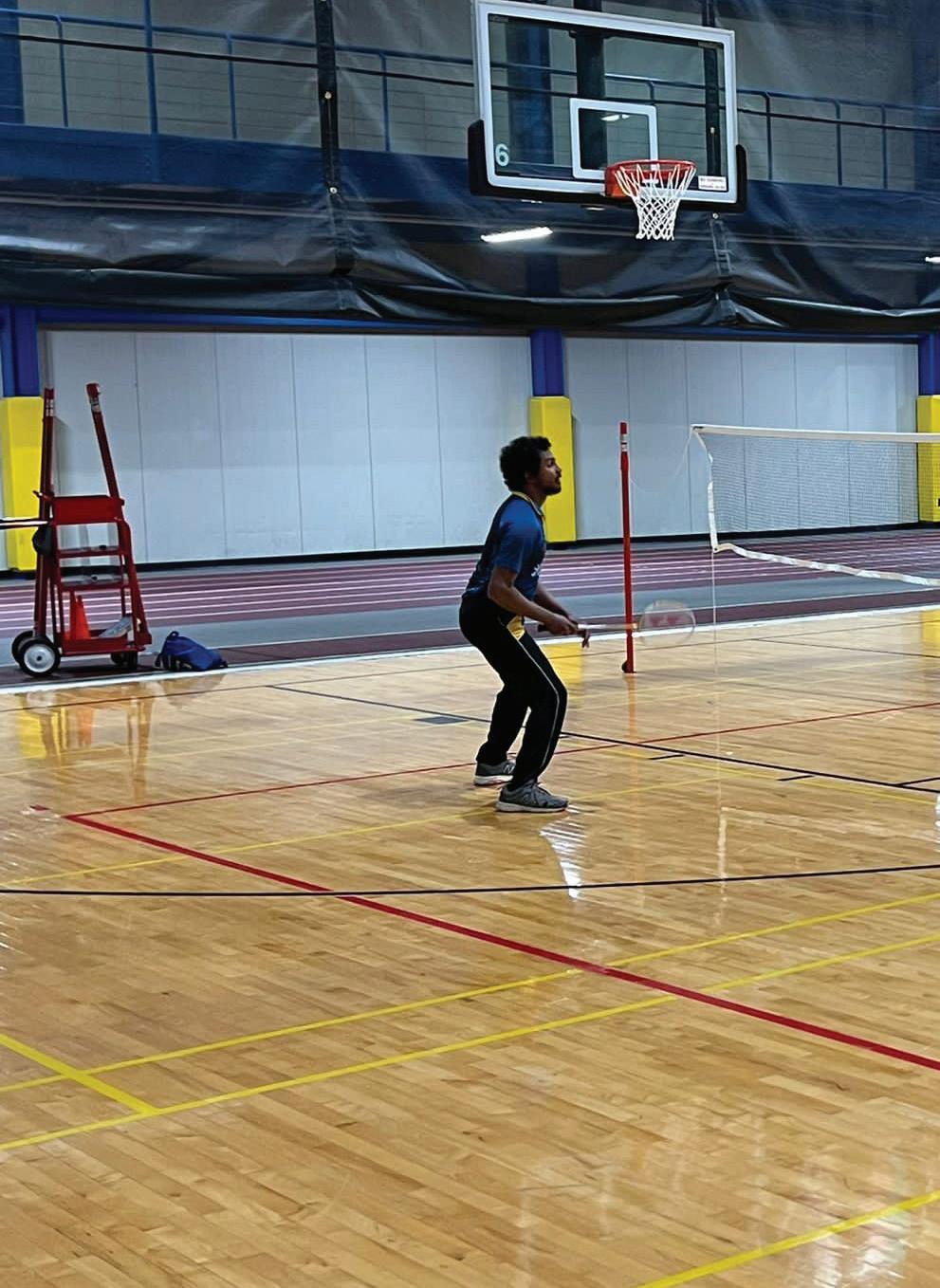


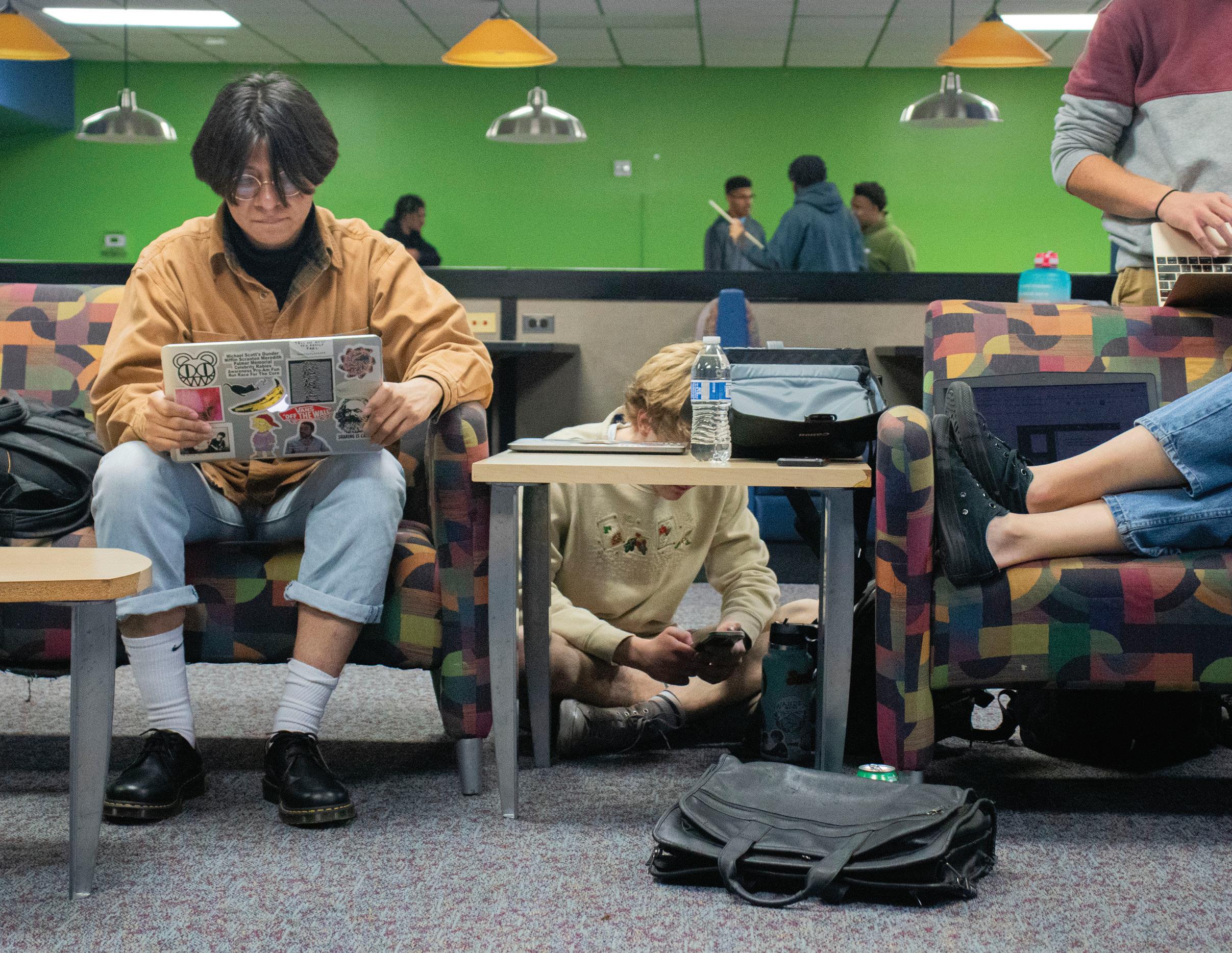
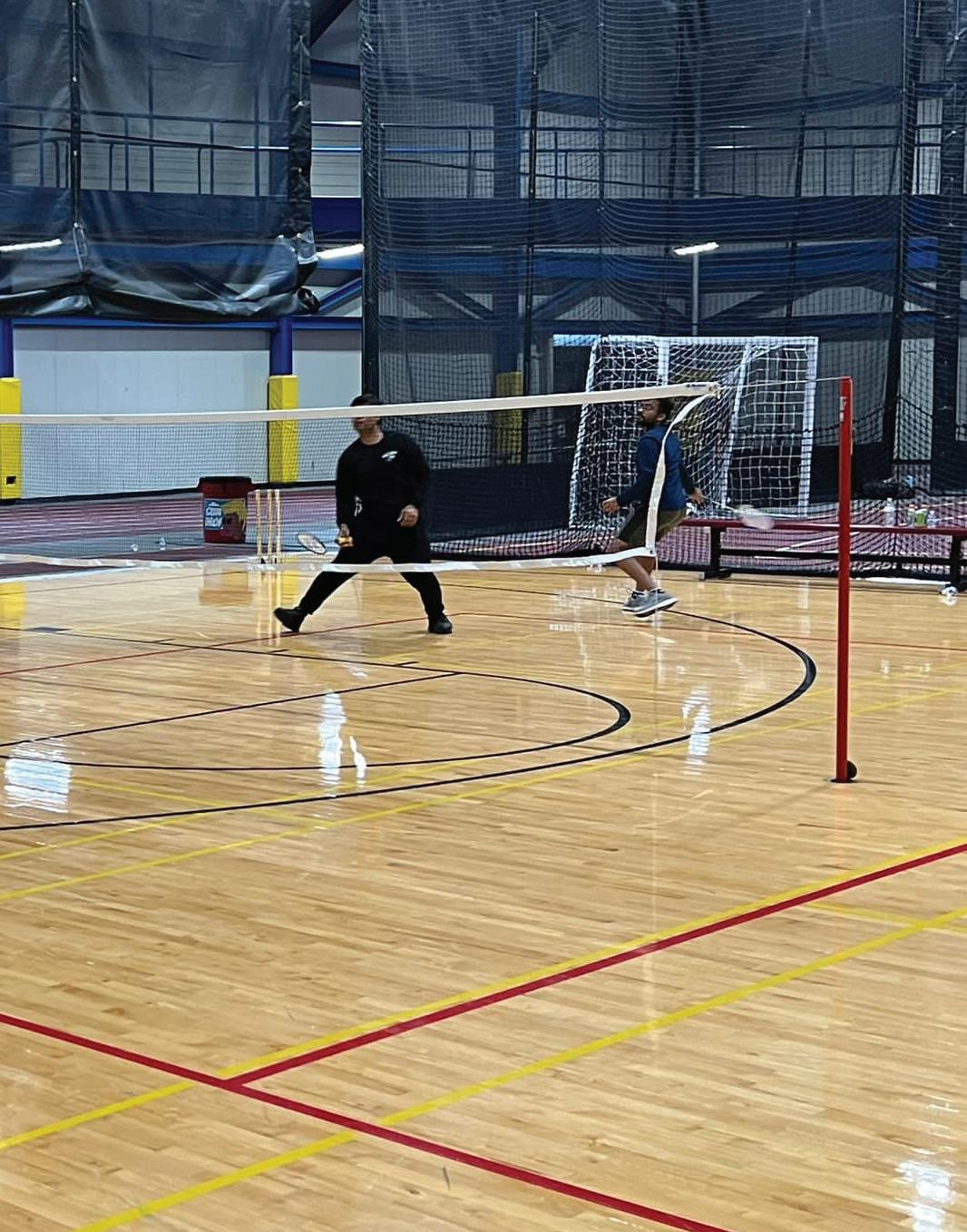


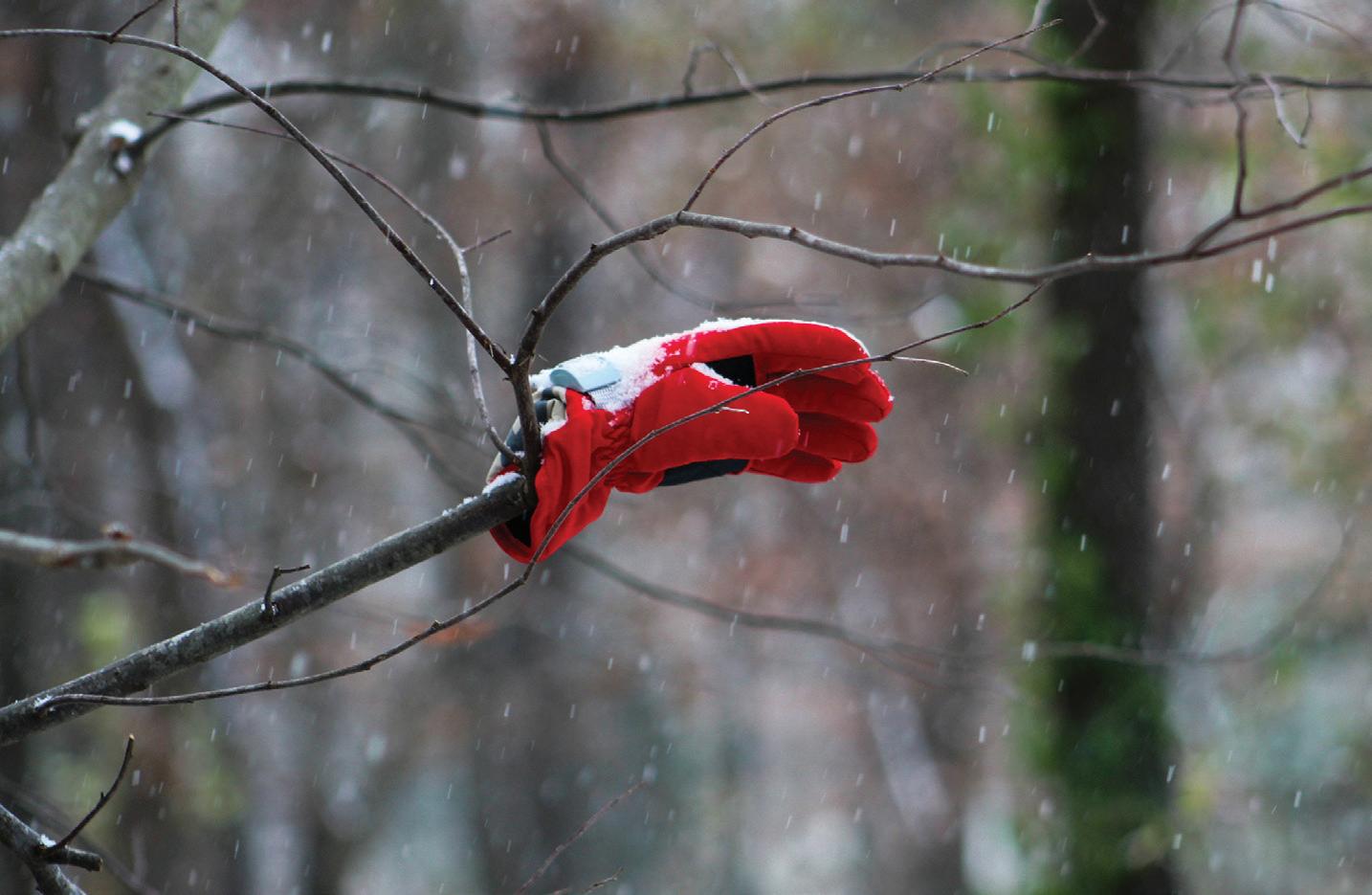

Many of our furry and feathered friends on campus were met with a shocking surprise when it began snowing early Saturday morning here in Carbondale. The snow reached its peak around 6:30 a.m. as the very light and scattered flurries briefly became intermittent light snow and began coating the ground at a maximum height of approximately 3.5 inches.
There are a wide variety of tree squirrels that can be found around campus, including but not limited to Eastern gray squirrels, fox squirrels and red squirrels, as well as a select few ground squirrels like eastern chipmunks and Franklin’s ground squirrels. Eastern gray squirrels are the most common squirrel species found in Carbondale and are known for their lively nature and surprisingly bold personalities when introduced to a constant influx of people.
There have been many different types of interactions between students and squirrels on campus, and I have
personally witnessed one, watching a particularly rotund Eastern gray squirrel throw a nut at a passerby. Unfortunately that passerby was myself… I had a bruise on my forehead for three days. These squirrels are the most known throughout campus life and even have a small social media presence.
Fox squirrels are also found on campus, but not as frequently due to their solitary nature and shy personalities and are only spotted with another member of their species during mating season. They are commonly mistaken for red squirrels because of the similar fur pattern and color, but are fairly easy to tell apart due to the fox squirrel being the largest tree squirrel within the Midwest and Eastern United States and are almost double the size.
Both the Eastern gray squirrels and Fox squirrels were seen running through the snow and getting to high ground Saturday morning so their small paws didn’t remain as cold as they would on tree branches where less snow could be found. The Eastern gray squirrels were seen more
frequently on the ground in comparison to the fox squirrels, however, and had a tendency to burrow through the snow to continue the search for nuts.

Campus Lake also received some wildlife action with an influx of Mallard and American black ducks paddling across the lake despite the frigid temperatures of the water along with the consistent falling snow. Mallards are by far the most common duck in Illinois and can be spotted anywhere wetlands and significant bodies of water are located. The main reason these ducks are so diverse in almost any wetland area is due to the fact that they are the ancestors of almost all domestic ducks and will mate with ducks from other species, further increasing their population size. Their colorful plumage is a dominant trait that identifies them as Mallards.
American black ducks were also seen wading in Campus Lake, but remained harder to see because there weren’t as many and blend in with the environment. Similar to the fox squirrel, they are known to not be social creatures and tend to shy away from most animals, making them slightly
harder to find in relatively suburban areas. The most shocking surprise of the snowy morning was a trio of Canadian geese joining the ducks on Campus Lake before taking to the skies once again. They can be seen as far south as Louisiana and Florida and have the capacity and migratory abilities to travel as far as 3,000 miles from their home destination. The most astonishing fact is the geese can cover about half the distance in as little as 24 hours. The cold of the water and the air has little to no effect on these geese and are the partial cause for their migration south.
Multiple species of perching birds were also seen flying through the trees outside West Campus when the snow began to let up and the sun started to shine. The snow may have not lasted long, but it was eventful for many of the animals to get a chance to experience winter a little early this year after a long bout of heat so late in the year.
In the little hours of freedom from the obstacles of the world, I like to doom scroll on TikTok for hours, rotting my brain into mushy mashed potatoes. I truly hate the app, but for some reason I cannot get myself to delete it. For some reason, it scratches that itch in my brain for short term content. Although I despise the app for taking away time from, I don’t know? Reading a book or something? I will not discredit the fact that it does have educational content among all the muck.
Of course, my “For You Page” is mostly made up of mostly antique dealers showing off things that I can only aspire to afford, and fashion designers and influencers showing off their amazing ensembles to go about their day in. You see, in fashion you have to look for the people that you draw inspiration from, and online, there are many folks wanting to be that for you. Sometimes it is incredible, and then sometimes it is actual garbage fire.
Not too long ago, while making my daily deepdive into the Internet, I clicked into a whole new group of fashion to me, and I was terribly intrigued. I love to layer, and it really doesn’t matter what time of year it is, if I want to wear two skirts at the same time, I am going to do it. While swiping away through my homepage, getting farther and farther along, ignoring every “Stop! You have been scrolling for way too long now!” the video that came along, I realized something very funny about the algorithm, and how it was thought I followed modesty rules.
I giggled and paused, thinking about myself, scanning my closet in my head in that instant. Then suddenly, I took a mental step back and thought to myself “Oh my goodness, sometimes I serve pentcostal realness, and it slays”. Now, I know that sentence makes zero sense, probably even more so to the Pentecstals themselves, but it is a good thing. It all has to do with two things: The bouffant hair, and the skirts.
Usually Tik Tok is showing me fashionable ways to make modesty work for you. It is usually an Orthodox Jewish woman showing off her amazing collection of babydoll dresses and tights, and trying on every sheitel (wig) that she owns, as they are unable to show their hair. The videos are always educational, and the women are always sure to inform the audience of her extent of
modesty.
A whole other section of the rabbit hole I fell into was the garment known as the “habit” worn by nuns of multiple denominations, mostly known for being represented as Catholic. That is some seriously comfortable looking stuff, as none of it has shape at all, and no clinging to the body. This piqued my interest, as my whole life I have been terribly uncomfortable with clothing that could be perceived as “too tight”. I was always afraid that someone would call me fat, or address that I was (more as a child than now, but still hanging onto for some reason) a chubby person. I mean, my favorite garment is a muumuu or a caftan. There is nothing better than feeling like Elizabeth Taylor in her latter years.
Some Muslim women cover their hair, their body, and sometimes even their face out of modesty.
Growing up, I was always incredibly intrigues by Muslim women in the store, as that was something that I was not used to seeing then. I was always fascinated
by the anonymity that the Burqa provides, and how their eyes were always the main focus, pulling the lingering eyes of men to meet with their own.
I used to always think to myself “Oh these poor women” for any women participating in modesty rules in any religion out there. It was hard for me to understand, as it looked like a form of oppression to me. Wearing something that someone else makes you wear is oppressive, and the only examples of modesty rules that I had witnessed, were forms of oppression.
Growing up in Catholic school, I had only 20 kids in my class. When I moved on from eighth grade, there were 10 of each gender in the room, and only 11 of us got held to modesty expectations, and that was the girls and little ole me. Although a boy, I am a femme presenting individual, and if my voice had have dropped, and my hair wasnt long, maybe this wouldnt have happened, but I was always held to the exact same standards as they did with the girls.
“Take your hair out of those braids
Aaron Elliott”, a teacher very politely said one day as I stood in line after recess. I froze, knowing that if I took my hair down out of the dutch braid that my friend had worked so hard on, I would be caught for being out of uniform. Somewhere in that thick book of rules that we re-read every first day, it read something along the lines of “Boys hair should not come any farther past the top of the backside of the collar on your shirt”. Since I was a bit mouthy, and quick on my feet I tried “Why?! I just did it! I’m not taking it down”, to which she insisted I do anyway. Pulling at my hair out from its daily updo, I complained and wasted so much time undoing my braid, I mean really being a hag. Finally, once I had released my locks, my teacher took a good look and giggled manically and said “That hair is getting a little long” while walking away.
The first thoughts that come to mid about modesty are of oppression that I witnessed myself. In Highschool, a small man with a big ego that was part of the administration would walk his bald self around, calling attention to
any shoulder, thigh, or breast that was “too much for other students” and did not follow dress code. This always filled me with anger, as boys could literally come to school with a shirt unbuttoned down to the equator and always got away with it.
It was finally my time to shine as soon as I heard the words “Elliott, those shorts are too short”. I whipped my head so hard, you’d think you would hear the crack. I stood there in a bit of silence instead of rebutting what this bald man had said before me. Yes, I am sure my that my shorts ere way too high, and yes I am sure that it was a stupid outfit, but really? I’m not naked, just mind your own. After about twenty seconds of unbroken eye contact, instead of pursuing some sort of write up for my distasteful outfit, he carried on with her rounds. I felt anger for multiple reasons all pointed at modesty, but my biggest one was that if I was a woman, he would have written me up with no questions asked.
You see, there are modesty rules for men, but they are not as strict by any means. Most of the time, the only parts of the body that needs to be covered for men are their buttocks and groin area, while being fully able to bear their chest for all to see. This has never sat right with me, as men’s chests have no purpose, while women’s breasts have a purpose. While researching modesty rules for men while writing this, I was still shocked by the endless list of dressing rules that women must follow, but the minuscule and quick list that men should abide by.
My question is this, is modesty always a form of oppression, or are there exceptions?

These women on TikTok make it look so easy, and most of all fashionable. Modesty isn’t all old cut up Miss Me jeans upcycled into a jean skirt anymore, as there is a whole market out there now dedicated to this. There are groups of women from all different backgrounds who come together and bond over fashion that they can wear out and about.
Many women still hold on and defend modesty, and to which I must state that I respect greatly, as to most it is a sign of personal strength and their love for whatever they believe in. Modesty garb is no longer just old jeans made into skirts and lots of long sleeve shirts, it is a whole lot more, and will continue to grow as the market for it becomes a world well known, which I am interested to see.

Usually a few times a year, a film will come out that takes everyone by surprise, launching to the tops of various year-end lists, with little marketing hype or fanfare to predispose an audience.

“TÁR” is as shocking as they come, with very little marketing theatrics or any major studio putting the film on a pedestal prior to audiences getting to judge it for themselves. Once the film began to premiere at festival circuits, the rumblings quickly began with exceedingly positive reception and talks of it being one of the very best films of 2022.
Even when I entered the theater to watch the film, knowing of all the audience reactions, I was still unprepared for what lay ahead of me. “TÁR” is a wholly unique cinematic experience, playing with audience expectations of the kind of awards season fodder the film will likely be lumped in with.
The film’s subversions, in fact, are so important that I would recommend anyone watch the film before reading any detailed reviews or analysis that might contain spoilers, for the best possible experience.
“TÁR” is a highly complex film that attempts to analyze and deconstruct the life of an artist (a fictional one contrary to common misconceptions that this is based on a real composer) and how ego affects the world of “high” art and even what the distinction is between what is arbitrarily considered high and low art.
It also deals with artists’ relationship with modernity, part of which involves “cancel culture,” a buzzword that has already lost all meaning through headlines, which the film also tries to deconstruct and deal with its implications. Although, attempting to simply call “TÁR” a movie about cancel culture would be regressive and minimize its intent.
Anyone who might consider themselves a creative will likely be made highly uncomfortable by this film in the best possible way. It portrays and comments on the idiosyncrasies and interpersonal failings that often are synonymous with well-respected artists or “geniuses.”
Cate Blanchett gives an otherworldly performance as Lydia Tár and creates one of the most three-dimensional and multilayered characters I have ever seen in a film. There was clearly a lot of practice, research and commitment to the role, as her character is so hyper-specific that it would be impossible to simply slip into, without proper preparation.
The director, writer and producer, Todd Field, also showed an immense level of care and commitment to the film. “TÁR” is Field’s first in more than 15 years, most of which I would not be surprised to learn were spent working on the film’s script, as the specificity of it is not something that would come out of simple research but requires years of examination of its subject material.
Field has a lot to say in the film, but compared to other auteur filmmakers, he says them much more confidently and free of pretension compared to how many others might when dealing with such complex themes and issues. “TÁR” is a wholly genuine, egoless film that is all about examining ego itself.
“TÁR” is also the antithesis of the cancel culture it deliberates on, as it refuses to present things in black and white. It shows the audiences many examples of Tár’s mistakes in her life but always gives both sides equal attention. What is most impressive is Field’s ability to feel like an unbiased voice, never completely siding with or against Tár, but rather letting the audience decide for themselves.
Although it may feel frustrating for some, the film’s resistance to give either Tár or those affected by her a triumphant, cinematic moment by the end of the film is completely necessary to what the film is trying to say about these complex interpersonal relationships.
There is a specific scene in which Tár is teaching a class and has a debate on the separation of the artist and their art, which later becomes one of the film’s main focuses. It displays both sides of the argument, both of which presented as valid answers. Although the scene itself may feel like it gives Tár the win, by the end of the film you’ll be questioning it from a completely new perspective.
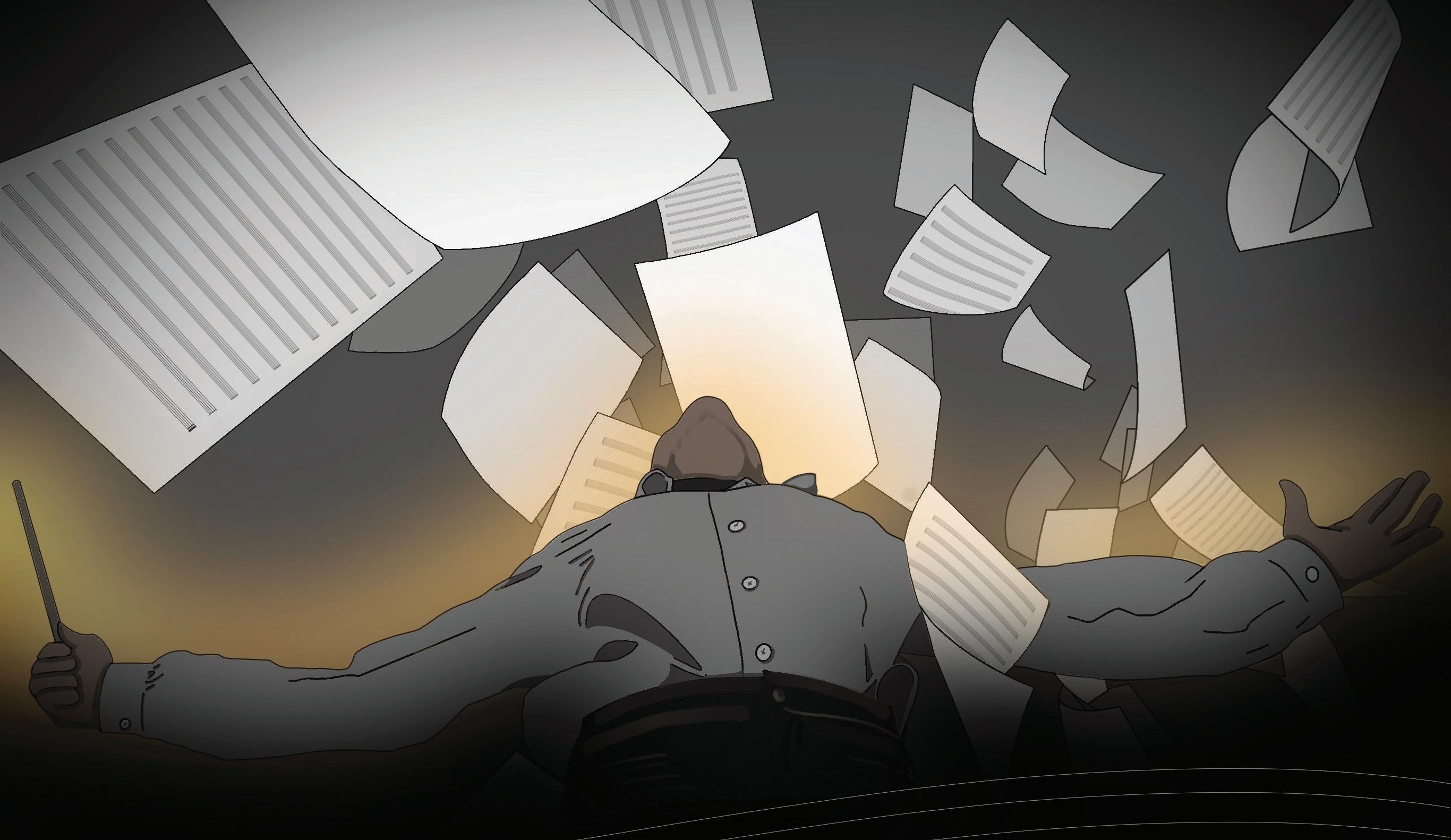
Aside from its transcendent performances and script, “TÁR” also is one of the year’s most technically impressive films. The subtle score blends perfectly with the explosive orchestra scenes and is extremely exciting once it does give the audience the release of seeing Tár finally perform.
The cinematography is subtle yet electrifying, utilizing negative space and shooting certain locations in a way that makes them feel otherworldly. Although, most of the film takes place in what could be considered mundane spaces. No shot is wasted, and the film is always visually stimulating.
The pacing is also possibly some of the best I’ve ever seen. The film is nearly three hours long, with most of the runtime being taken up by dialogue-heavy scenes taking place in un-extraordinary circumstances. Despite this, I didn’t even want to leave the theater to use the restroom, even in scenes as seemingly unimportant as Tár having lunch. I could have easily watched three more hours with how enthralled I was from beginning to end.
The film’s editing, performances, direction, cinematography and pretty much every behindthe-scenes aspect all work in perfect harmony, not unlike the orchestra Tár herself conducts, to make a perfect piece of filmmaking.
“TÁR” is a highly ambitious film that succeeds on many fronts. It provides a fascinating character study of what it means to be a successful artist, artistry in the digital age, pretentiousness in the art world, the relationship between victims and their aggressors and so much more.
It would be foolish to attempt to distill
everything that makes “TÁR” great in one short review, but it is easily one of the year’s best; I would recommend it to anyone open to a challenging and immensely stimulating time at the movies.
Nicholas | bnicholas@dailyegyptian.com
Rating: 10/10
Staff reporter Zaden Dennis can be reached at zdennis@dailyegyptian.com and you can find his other reviews at letterboxd.com/Zadenator.
With the football and volleyball teams coming close to the end of their seasons, and men’s and women’s basketball hitting the ground running at the same time as swimming and diving, the Southern Illinois University Dawg Pound is looking at a full calendar to end the year.
The Pound is the student section at Southern Illinois, which not only packs Saluki Stadium and the Banterra Center to cheer on all of the Saluki sports teams each season, but also travels to away games each year to take the home court advantage away from the opponents.

“The Dawg Pound creates the atmosphere in the Banterra Center during a game. When it comes to being engaged, possession to possession and bringing the true energy, I think that everyone feeds off the Dawg Pound, including ourselves,” said men’s basketball senior guard Trent Brown.
The Pound is run by President Dylan Chambers and Vice President Madison Giltner, who are both juniors. Chambers has been in charge of the Pound since post-Covid 2021, Giltner recently took her position and the Pound has only grown since then.
The focus of the Dawg Pound is to not only cheer on all of Southern’s athletic teams, but to help break the barrier between students and student athletes and create a sense of community.
“The Dawg Pound brings a different light to the university, compared to the other 300 organizations, highly because we deal with athletics and students together. We do a lot of things that the other organizations do,
like community service and getting involved around campus, but we also have different opportunities thanks to athletics,” Chambers said.
Giltner agreed saying, “Seeing the interactions between students and the athletes because of the Dawg Pound is like there is nothing separating them.”
In the past year, the Pound has given its members the opportunity to travel to an away football game at Northwestern University and to two away men’s basketball games: Indiana State and Illinois State. This is something that sets the Dawg Pound apart from not only the other campus organizations, but other student sections in the Missouri Valley Conference.
“We may not be the biggest crowd in those away arenas, but we’re always going to be the loudest to show our teams that we support them anywhere,” Giltner said.
With men’s basketball playing their first home game of the 2022 season on Nov. 7 at the Banterra Center, the Dawg Pound passed their previous season attendance with more than 2,000 students in attendance.
“We want to continue to make history each time we file into that student section for a basketball game,” Chambers said.
The atmosphere in the Banterra Center is brought by the Dawg Pound each and every game. From standing until the Salukis score their first points of each half, to confetti cannons and reading the Daily Egyptian when the line up of the opposing team is read, there is no student section in the Valley quite like the Dawg Pound. These are just some of the things that show the athletes that the Pound has their back.
Traveling to away games is another way the Dawg Pound shows how big their love for Saluki athletics is.
“It makes us feel so supported, it feels like we’re working for something bigger than ourselves that people care about what we’re doing enough to take their time to not only watch our game but come on the road with us just to show us that they support us,” Brown said.
The Dawg Pound doesn’t only affect the players on the court, but also fans in other seats, like season ticket holders sitting on lower levels. The Pound helps the rest of the crowd get engaged with the game.
“If the Dawg Pound wasn’t there, I feel like it would be dead silent in
the Banterra Center, we bring the Banterran Magic,” Giltner said.
The Pound was noticeably absent during the COVID year when fans were not allowed in the arena. Brown said it was a drastic change for the team to adjust to.
“With COVID, we had to bring out our own energy every single game. If your body wasn’t feeling the best, it was a quiet gym, it felt like the very beginning of warm ups, but the whole time. It just was not the same,” Brown said.
With a more-than-packed arena for the first home game of the season and the addition of multiple new schools to the MVC, including Murray State, the Dawg Pound has more big things
“When I was in my high school my father was dependent on his friends, on my uncle’s to take advice regarding me,” said Digvijay Verma, an Indian masters student who’s father paid for his private highschool education. “But now my relatives asked me because I’m educated now. They ask me about their children. What background should they be? What course should they take? In which university they should go? Because they know that I faced this problem, but now they are not facing the problem because I am their family member.”
This is not to say that Indian students aren’t here on their own merit. Many have paved their way through higher education on merit alone after their parents got them started in school.
“With great difficulty, I came here,” Ashish said. “With great difficulty financially, emotionally… because when I get my scholarship - my graduate assistantship - I have to send this money to my parents
because they are totally dependent on me, we don’t have anything. I get 700 dollars in my hand every month, and I send 400 dollars back home.”
Ashish and others like him are unable to work in the US under student visas, so sending home what little money they are given is not an easy sacrifice to make.
Though education has become more commonplace in India throughout recent decades, even the previous generation of middle-caste Indians received lackluster educations.
“There are hardly any people who were educated at that time, there was very little education. You know, at that time, sixth grade is when they used to learn their ABCs. Sixth grade and they just know their ABCs,” Redhu said.
Redhu comes from a rural area of Northern India, from the state Haryana. People in this area are descended from warrior Sikhs that defended India from western invasion for centuries. The burden of the defense of the entire subcontinent fell on their shoulders, due to the natural choke point formed by the Himalayan mountains and the
Arabian Sea. Thanks to this legacy as well as extensive modern military activity in Haryana, Redhu’s caste isn’t considered to be so lowly as the SC or ST castes.
Whereas other governments have the ability to support farmers by insuring them against yield fluctuation, natural disasters, and market conditions beyond their control and subsidizing many of their expenses, India has not been as successful in this area. According to Redhu and India’s government websites, 70% of farmers own 2.5 acres or less according to India’s latest Agricultural Census.
“And still people are traditionally associated with their occupation, they just know farming. Without education, they are not aware about other resources, they don’t know what they can do,” Redhu said. “They’re not skilled in other occupations. So they are dependent on farming. And nowadays because the size of the land is decreasing, they are not benefiting from farming.”
As the modern age catches up with India, many jobs are being
created in tech and service sectors, but uneducated farmers are unable to adapt.
“If you ask anyone, any kid in India, what do you want to become they’ll say, ‘easy, I want to become a doctor, I want to become a lawyer, I want to become this’, nobody says, ‘I want to become a farmer’, because it’s not a good business, a survival business,” Redhu said.
He would know. Redhu worked the fields of his family’s five acre plot his entire life up until school took him away from the struggles of his family. For small land owners, the large agricultural machines that make farming easier in developed countries are unaffordable. Nearly all of the work that is done on the farm is done by hand in the heat, leaving little time or energy for anything else. Redhu’s mother is illiterate, and his father quit school at the 9th grade to fill in for Redhu’s grandfather, who was too old to work the family farm.
Redhu’s most life changing moment was when he lost a finger to a foraging machine designed to cut up crops for farm animals
planned for this season. Continuing to make the game experience better for the students is what the Dawg Pound is most concerned about this season.
Coming up, students can expect possible giveaways at big games, the very first Rally around the Pound game to support mental health awareness sponsored by SIH and traveling to more away games.
This winter, the Dawg Pound is excited to continue its tradition of bringing its magic to the Banterra Center each game through their electric, supportive and energetic loyalty to Saluki athletics.
Sports reporter Joei Younker can be reached at jyounker@dailyegyptian.com.
to eat, making him ineligible for military service, a popular method of escaping a farmers life in Haryana. His only option was to pursue an education in sciences, which eventually led him to pursue his PHd in Agricultural Science.
Exams to enter college are incredibly competitive in India, with many students paying small fortunes for private schooling and tutoring in order to have a chance of gaining entrance into a good school.
Redhu was supported by his parents throughout his education. His whole community knew the value of education, if only they were able to achieve it.
“They always supported us. They work hard themselves so that we can study, so that we can grow,” Redhu said. “Like a person who wants to be a champion in olympics, he wants to win a gold medal and he missed it. Then they say, ‘ok, my kid will make it.’ So they put everything towards it.”
Staff reporter Daniel Bethers can be reached at dbethers@dailyegyptian.com.
On Feb. 27, 2021, coach Nick Hill’s Salukis scored one of the biggest wins in program history, an upset at home against North Dakota State. The Bison went into that game ranked No. 1 in the FCS with a 39-game winning streak, and SIU quarterback Nic Baker was making his first career start.
North Dakota State returned to Carbondale on Saturday, and the Salukis hoped for that same upset magic to happen. Instead, they fell short of striking again, as the Bison came away with a 21-18 victory. The loss extends Southern’s losing streak to three games, and brings them to 5-5 on the season.
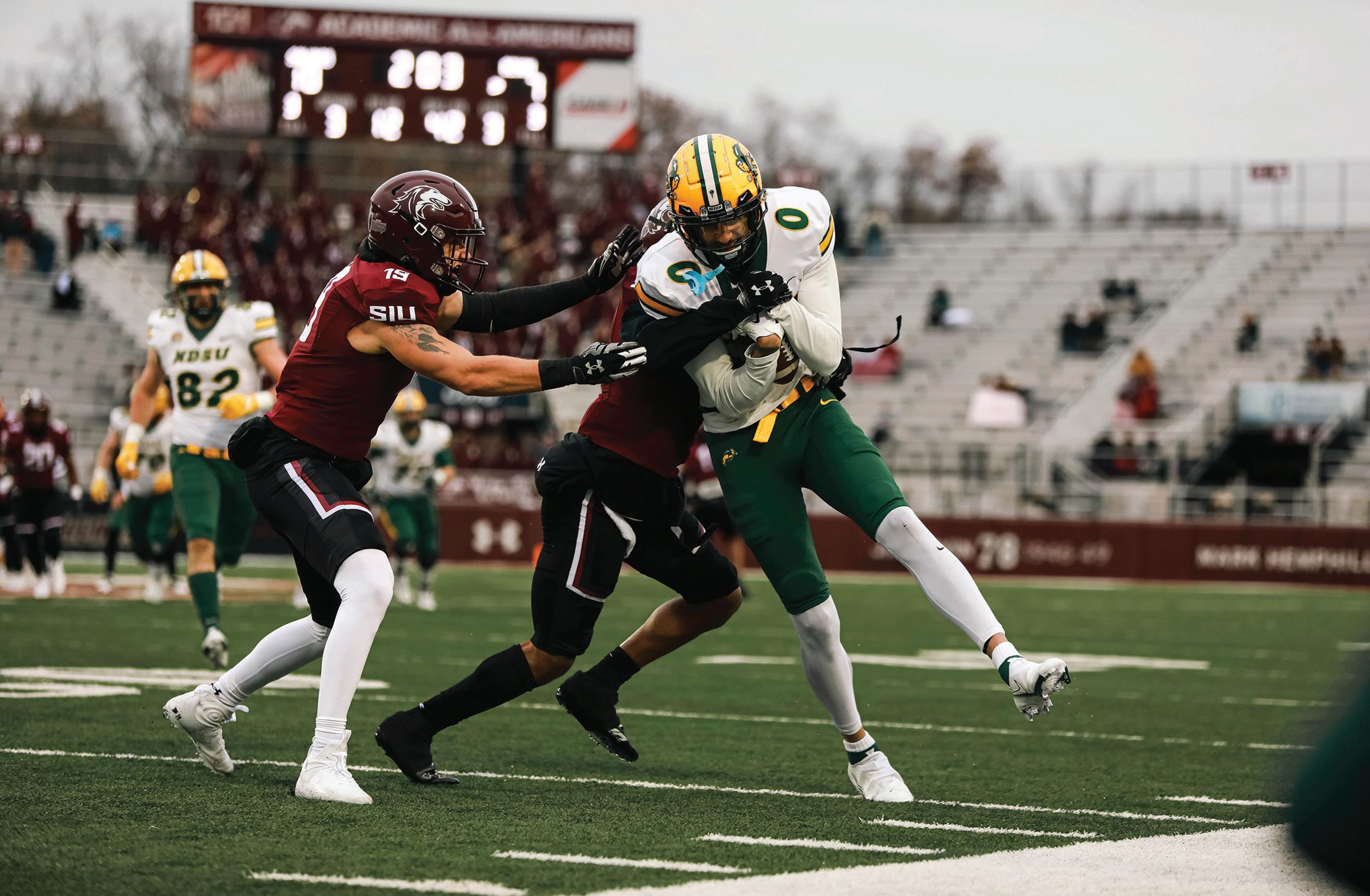
“It was two good teams battling,” Hill said. “I’ve said that several times this year. We’ve got to find a a way to be on the other end of it.”
Ultimately, Southern Illinois’s last chance to sneak back into playoff consideration did not work out for them. While the final score was close, it rarely felt like the Salukis had control of the game, even when they had the lead.
That 10-7 lead, which the Salukis grabbed on a Jacob Garrett touchdown run with 5:18 to go in the third quarter, was immediately undercut by 30 yards worth of penalties – one for unsportsmanlike conduct and one for targeting – on the ensuing kickoff. This gave North Dakota State the field position needed to mount a touchdown drive, which gave the Bison a lead they would never relinquish.
“Penalties change the flow of the game,” Garrett said. “You could argue that we had all the momentum there, and then we kinda just nulled it with those two penalties.”
The Saluki defense held strong for most of the game.
After giving up a touchdown on the first NDSU drive, Southern held the Bison to just 23 total yards on 16 plays across their next four possessions.
This came despite the offense struggling in the first half, as three of the first four SIU drives ended as punts in enemy territory, and the other was an interception thrown by Baker, only his second since that SEMO game in
September.
Despite those issues, the defense picked up the team, and helped it along by keeping the game close for most of the afternoon.
“When you’re a defensive player, you can’t let the situations of the game dictate how you’re gonna go out and play that series,” Hill said. “That’s what you are. You’re a defense. You’ve got to get your team out of trouble.”
One of the more crucial offensive possessions for Southern came at the end of the first half. Down 7-0, the Salukis were given a short field after a punt, and only took one play to get inside the 10-yard-line with less than two minutes to go. Needing a score before the half, they gained two total yards on the first two downs.
On 3rd-and-goal from the NDSU 7, the Salukis called a trick play where Baker threw a lateral to offensive tackle Jake Green. The play went backwards, and Southern settled for a field goal. Had they scored a touchdown on that drive, they would have had a chance to tie the game later on.
“That’s definitely crucial,” Garrett said. “But at the time, it’s good to come away with points right there. That’s still a win-win kind of situation, where you want to finish the half well.”
Both offenses picked up in the second half. After the Bison began with a three-and-out, Southern marched down the field for a 13-play 60-yard drive capped off by Garrett’s rushing
flip after halftime. NDSU was 5-for7 on third downs in the second half, and had two drives of double-digit play counts to chew up clock when Southern Illinois needed it most.
“Key emphasis at practice is, get off the field on third downs,” senior linebacker Ma’kel Calhoun said. “Those third down completions really hurt us.”
Having been with Southern Illinois for six years, Calhoun faced the possibility of Saturday being his last home game as a Saluki. With playoff chances dwindling, that possibility came much closer to reality.
“Definitely a game that I’ll remember for the rest of my life,” he said. “Very emotional, sad loss.”
Saturday’s game felt symbolic of this Saluki team as a whole. While they showed the capability to hang with the best the Missouri Valley has to offer, one team came through when it faced adversity, while the other didn’t quite have enough to put it away.
Words cannot do justice to North Dakota State’s dominance over FCS football since 2011. The Bison have won nine FCS National Championships in 11 seasons, received votes in the AP Top 25 despite being in a lower level, and won at least a share of the Missouri Valley Football Conference title in every year that wasn’t shortened by a pandemic.
For the Salukis to play competitively with North Dakota State is an accomplishment in itself. Entering Saturday, the Bison had only played two FCS games this season where the final margin was one possession. But there are no moral victories for SIU when the team is on the losing end.
Southern’s upset of North Dakota State in 2021 proved that the team was not unbeatable, even by an unranked team like SIU had become during their recent losing skid. However, aside
The aforementioned 2021 upset propelled the Southern Illinois into the FCS rankings for the first time since 2014. They would stay there for the rest of that year and the next, before finally breaking a 23-week streak of appearing in the polls when they were upset at home by Southeast Missouri State in September.
After that SEMO upset, the Salukis pulled off the other marquee win in Hill’s tenure when they beat Northwestern, the first time SIU had beaten a Big Ten team since Hill was the team’s quarterback in 2006. It began a stretch of five straight wins, where Southern Illinois seemed on track for its third consecutive playoff berth, and possibly the MVFC title.
Then, the cracks started to show. Southern blew a 14-point lead against South Dakota, then-winless in the Valley, for its first loss in conference play. Then, a loss at home to Northern Iowa when a hail mary attempt fell just one yard short. Suddenly, the Salukis were facing the toughest task possible, with their season virtually on the line.
While the 2021 win over NDSU catapulted the Salukis into contention, this year’s loss may be the nail in the coffin for their postseason hopes.
Southern sits at 5-5 and faces the possibility of not only being left out of the FCS playoffs, but finishing the 2022 campaign with a losing record. It should be noted how many of those losses came down to the wire. Aside from an opening week blowout against Incarnate Word, every other Saluki loss was by a field goal or less.
“We were giving effort until the last whistle there. Ultimately we came up short,” Garrett said. “We just need to be able to finish those games. Our four losses, that’s been the telltale story.”
It’s been a bit of a pattern for Nick
In 2020-21, the Salukis lost three of their last five games. Last year, they lost four of their final six. On Saturday, they made it three straight losses with just one game to go.
While this season isn’t necessarily a disaster, it’s certainly a disappointment for everyone involved. Expectations were high, entering as the ninthranked team in the FCS. At times, they showed what they were capable of, from upsetting a Big Ten school to breaking off five straight victories in one of the toughest conferences in the country. But ultimately, the season will likely fall well short of any championship aspirations.
Saluki football is by no means in a dark age. We are well past the losing years that defined Hill’s early tenure. But given the elevated expectations, the program is underperforming what many thought they were capable of, including the players themselves. It’s not just about the North Dakota State loss, but it never should have come down to a game like this in the first place.


Southern Illinois will have its final regular season game on Nov. 19 when it visits Youngstown State (6-4, 4-3). The odds are not high that the Salukis will sneak into the playoffs, but Hill’s message to the team is to keep their head high. After all, anything can happen on a college football Saturday.
“We all have a job to do,” Hill said. “That doesn’t really affect us. No matter what our record is, we all here represent this school, this university, this program. You show up every single day ready to work, ready to grow and get better, until they tell you your season’s over.”
reporter Brandyn Wilcoxen can be reached at bwilcoxen@ dailyegyptian.com or on Twitter @BrandynWilcoxen.




